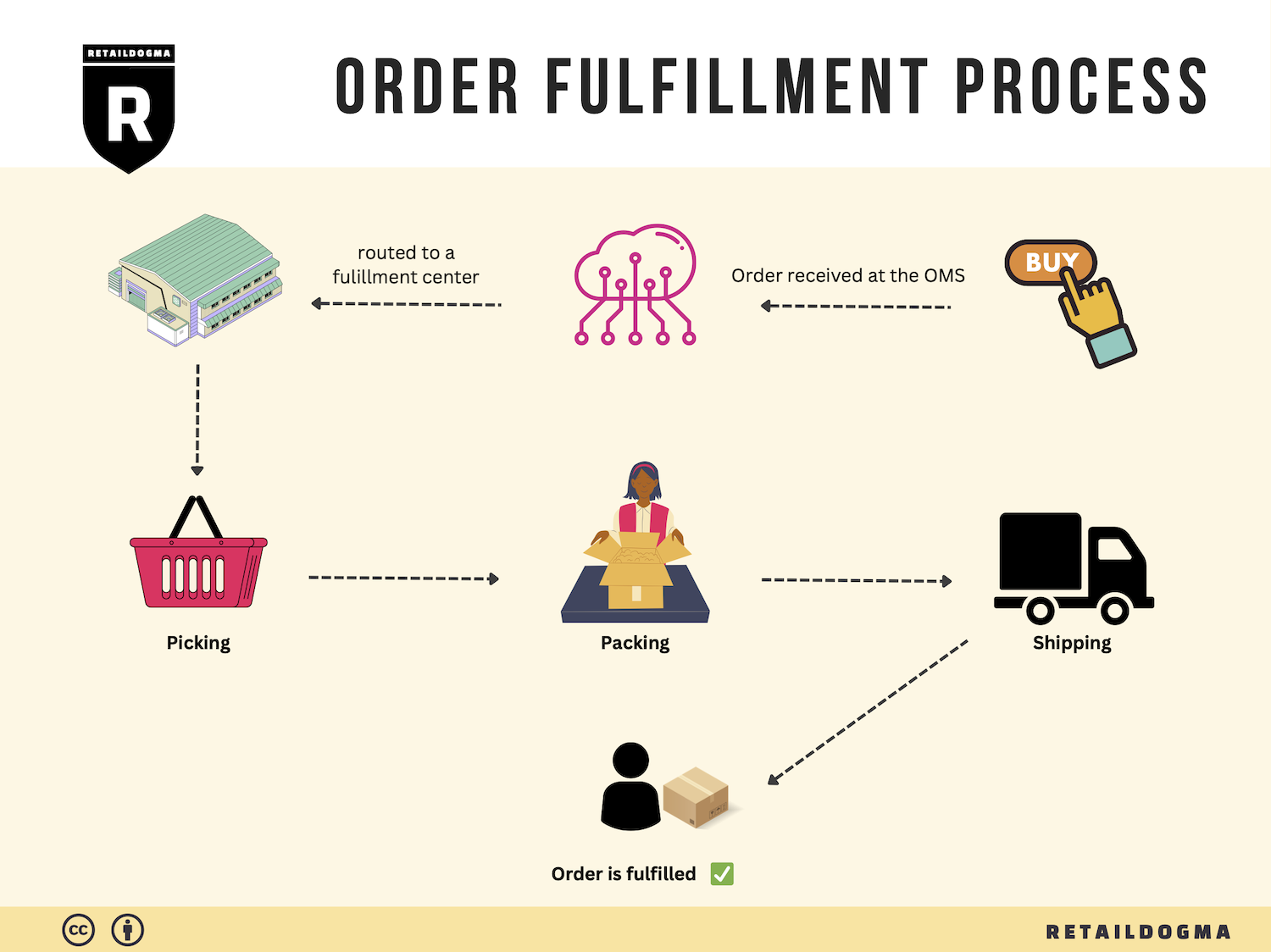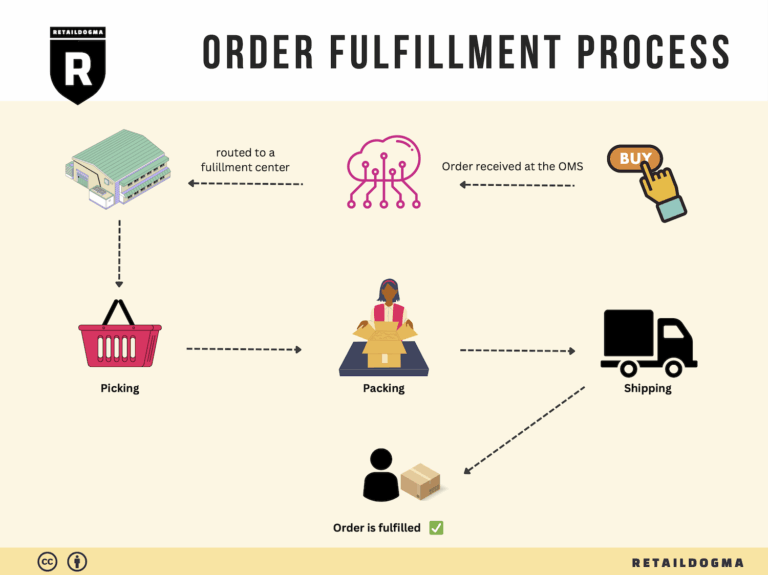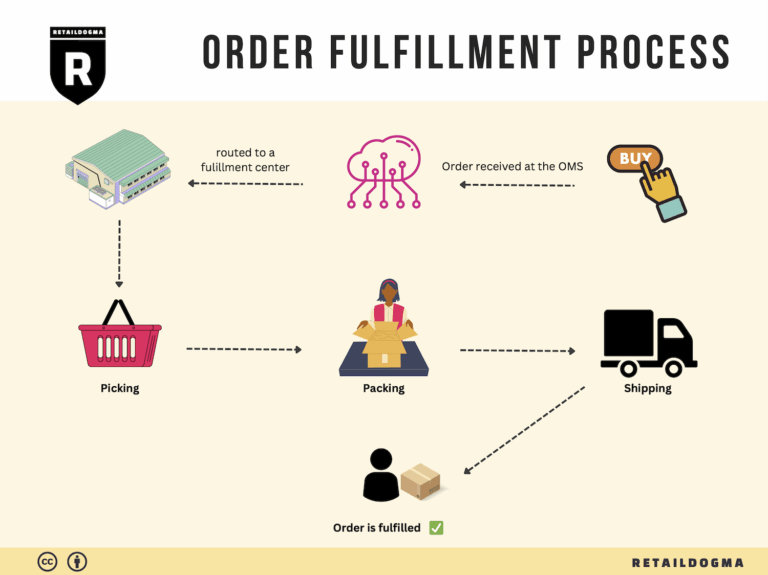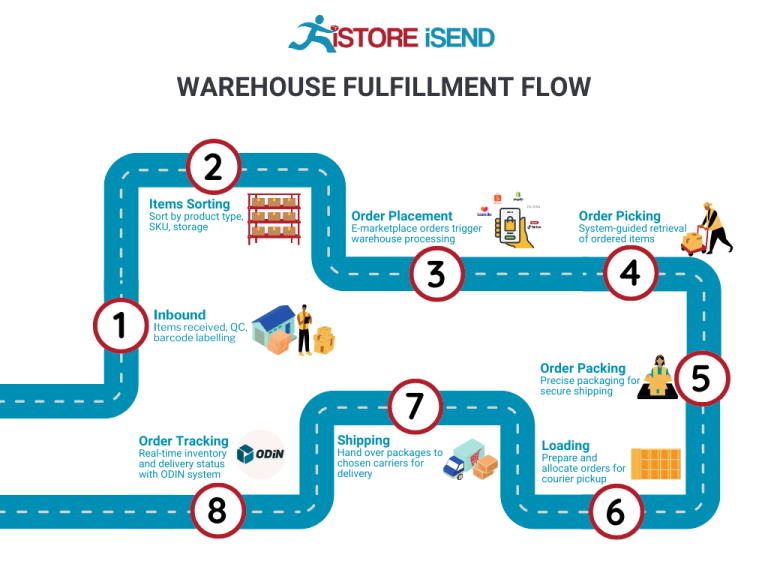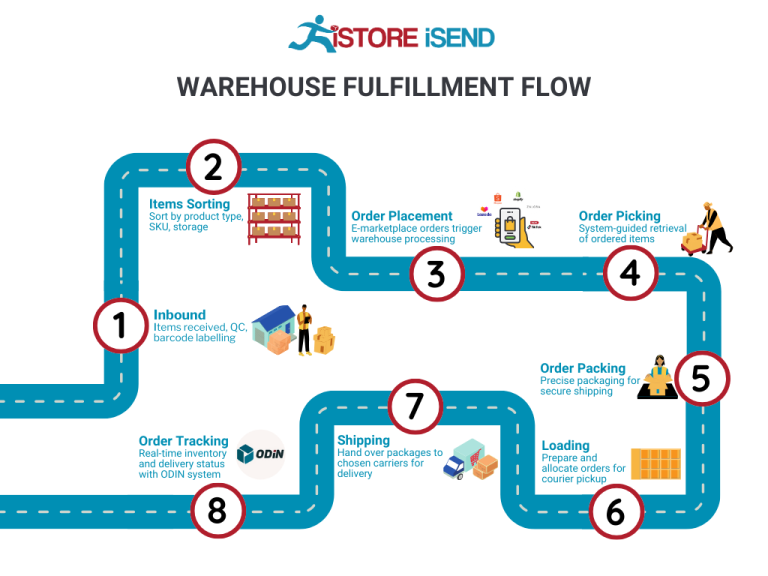How Order Fulfillment Works: A Step-by-Step Guide for Businesses
What is E-commerce Fulfillment? An Introduction for Growing Businesses
Understanding E-commerce Fulfillment
For many growing e-commerce businesses, the excitement of expanding product offerings and reaching new customers can quickly turn into a daunting challenge when it comes to packing and shipping orders. As sales increase, so does the complexity of fulfilling those orders efficiently and accurately. This often leads to overwhelm, as business owners juggle inventory management, shipping logistics, and customer service—all critical components of the fulfillment process.
Fulfillment, in its simplest form, is the process of getting a product from your warehouse or storage facility to the customer’s doorstep. This process encompasses everything from receiving and storing inventory to packing and shipping orders. For businesses looking to scale, understanding fulfillment options is essential to maintaining customer satisfaction and operational efficiency.
In this guide, we will explore various fulfillment models, including Third-Party Logistics (3PL) and Fulfillment by Amazon (FBA). Each model offers distinct advantages and can be tailored to meet the specific needs of your business. We will also delve into the core services associated with fulfillment, such as inventory management, order processing, and shipping solutions, to provide a comprehensive overview of what to expect when partnering with a fulfillment provider.
Choosing the right fulfillment partner is a critical decision that can significantly impact your business’s success. We will discuss key factors to consider when evaluating potential partners, including their technology capabilities, geographic reach, and customer service standards. Additionally, we’ll provide insights into pricing structures, helping you understand how to budget for fulfillment without compromising service quality.
The ultimate goal of this guide is to empower e-commerce business owners, operations managers, and entrepreneurs to make informed decisions about their logistics strategy. By understanding the intricacies of e-commerce fulfillment, you can streamline your operations, enhance customer satisfaction, and focus on growing your business rather than getting bogged down in the logistical details. Whether you are just starting out or looking to refine your existing processes, this guide will serve as a valuable resource in navigating the world of e-commerce fulfillment.
What You’ll Learn In This Guide
- What is E-commerce Fulfillment? An Introduction for Growing Businesses
- The Order Fulfillment Process: From ‘Buy’ Button to Customer’s Door
- Comparing Fulfillment Models: In-House vs. 3PL vs. Dropshipping
- A Deep Dive into Amazon FBA: Pros, Cons, and Who It’s For
- Core Services Offered by Fulfillment Centers
- How to Choose a Fulfillment Partner: A 6-Point Checklist
- Understanding Fulfillment Pricing: A Breakdown of Common Fees
- Frequently Asked Questions (FAQs) about Fulfillment
- Conclusion: Is Outsourcing Fulfillment the Right Move for Your Business?
- Important Disclaimer
The Order Fulfillment Process: From ‘Buy’ Button to Customer’s Door
1. Receiving Inventory
The first step in the order fulfillment process is receiving inventory. When products arrive at the fulfillment center, they are unloaded and inspected for quality and accuracy against the purchase orders. This step is crucial as it ensures that the right products are available for future orders, minimizing errors and discrepancies down the line.
During this stage, each product is assigned a Stock Keeping Unit (SKU), which is a unique identifier that helps in tracking inventory levels and sales data. This systematic approach allows businesses to maintain accurate records and manage stock efficiently. Proper receiving processes can significantly reduce the chances of stockouts or overstock situations, which can impact customer satisfaction and overall operational efficiency.
2. Warehouse Storage
Once inventory is received and accounted for, it is stored in the fulfillment center. Effective warehouse storage is critical for optimizing space and ensuring that products can be accessed quickly when orders are placed. This involves strategic placement of items based on various factors such as size, weight, and demand frequency.
The use of advanced warehouse management systems (WMS) allows businesses to categorize and store items in a way that maximizes efficiency. For example, high-demand products may be placed closer to the packing area to reduce picking time. Additionally, employing FIFO (First In, First Out) methods helps manage perishable goods effectively. Efficient storage not only saves time but also reduces labor costs and enhances the overall order fulfillment speed.
3. Order Picking
Order picking is the process where items are selected from their storage locations to fulfill customer orders. This step is vital as it directly impacts the accuracy and speed of order fulfillment. To streamline this process, businesses utilize pick lists, which outline the specific items and quantities needed for each order.
There are various picking methods, such as single order picking, batch picking, and zone picking, each suited to different business models and order volumes. Implementing a well-defined picking strategy can enhance productivity and reduce errors. For instance, batch picking allows warehouse staff to pick multiple orders at once, significantly increasing efficiency, especially in high-volume environments. Effective order picking ensures that customers receive the correct products in a timely manner, leading to higher satisfaction rates.
4. Order Packing
After items are picked, they move to the packing stage, where they are prepared for shipment. This step involves verifying the picked items against the order details to ensure accuracy. Proper packing is essential for protecting products during transit and providing a positive unboxing experience for customers.
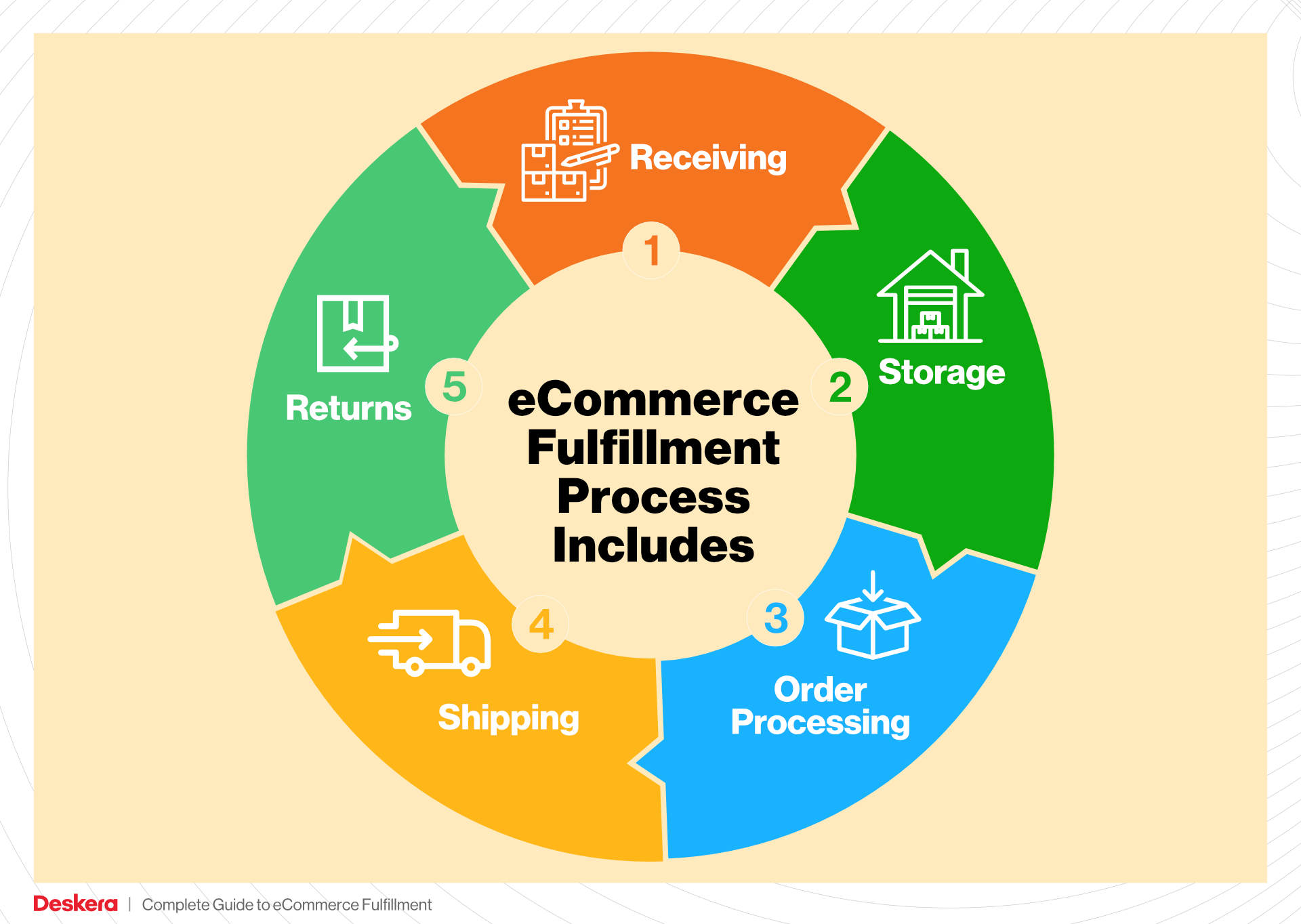
Key terms associated with this step include packing slips and shipping labels. Packing slips detail the contents of each package, while shipping labels contain vital information for delivery. Businesses must also consider the use of appropriate packaging materials to prevent damage and optimize shipping costs. Effective packing not only safeguards products but also reinforces brand identity through thoughtful presentation, enhancing customer perception and loyalty.
5. Shipping & Delivery
The final step in the order fulfillment process is shipping and delivery. Once packages are packed, they are handed over to shipping carriers such as UPS, FedEx, or USPS for delivery. This step is critical, as it determines how quickly and efficiently customers receive their orders.
Timely shipping is particularly important for maintaining customer satisfaction, especially for businesses that offer expedited services like Amazon Prime. Integrating shipment tracking systems allows customers to monitor their orders in real-time, enhancing transparency and trust. Furthermore, businesses must manage shipping logistics effectively to minimize costs while ensuring timely delivery. By optimizing shipping routes and selecting the right carriers, companies can enhance their fulfillment capabilities and scale their operations efficiently.
In summary, the order fulfillment process is a complex yet essential aspect of e-commerce that involves meticulous attention to detail at each stage. By understanding and optimizing these five key steps—receiving inventory, warehouse storage, order picking, order packing, and shipping & delivery—businesses can ensure a seamless experience from the moment a customer clicks the ‘Buy’ button to the time their package arrives at their doorstep.
Comparing Fulfillment Models: In-House vs. 3PL vs. Dropshipping
Fulfillment Model Comparison
| Model | Who Handles Inventory | Best For (Business Stage) | Key Advantage | Key Disadvantage |
|---|---|---|---|---|
| In-House Fulfillment | The business itself | Startups to medium-sized businesses | Full control over inventory and operations | High upfront costs and resource-intensive |
| Third-Party Logistics (3PL) | A third-party logistics provider | Growing to larger businesses | Scalability and expertise in logistics | Less control over inventory and potential delays |
| Dropshipping | Suppliers or manufacturers | New businesses and niche markets | Low startup costs and minimal risk | Lower profit margins and reliance on suppliers |
In-House Fulfillment
In-house fulfillment involves managing all aspects of inventory handling, storage, packing, and shipping within the business’s own facilities. This model is particularly advantageous for startups and medium-sized businesses that want to maintain complete control over their inventory and fulfillment processes. One of the key benefits of in-house fulfillment is the ability to implement tailored processes that align with specific business needs and customer expectations. Businesses can fine-tune their operations, enhancing customer service and potentially reducing lead times. However, this model comes with significant challenges, such as high upfront costs associated with acquiring warehouse space, hiring staff, and investing in technology. Additionally, it can be resource-intensive, requiring ongoing management and operational oversight, which can divert focus from core business activities like marketing and product development.
Third-Party Logistics (3PL)
Third-party logistics (3PL) is a model where a business outsources its inventory management and fulfillment operations to an external logistics provider. This option is ideal for businesses that are in a growth phase and need to scale their operations without the burden of managing logistics internally. 3PL providers offer a wealth of expertise in supply chain management, allowing businesses to leverage advanced technologies and optimized processes. They can handle warehousing, packing, shipping, and even returns, freeing up business owners to focus on strategic initiatives. A significant advantage of using 3PL is scalability; businesses can adjust their logistics needs based on demand fluctuations without heavy investments in physical infrastructure. However, a drawback is the reduced control over inventory management, which can lead to potential delays or inaccuracies in order fulfillment. Businesses must also rely on the 3PL provider’s performance, which can vary significantly across providers.
Dropshipping
Dropshipping is a fulfillment method where the retailer does not hold inventory but instead transfers customer orders directly to a supplier or manufacturer, who then ships the products directly to the customer. This model is particularly attractive to new businesses and those operating in niche markets due to its low startup costs and minimal risk. Entrepreneurs can launch an e-commerce store without the financial burden of purchasing inventory upfront. Additionally, dropshipping allows for a wide range of products to be offered without the need for storage space. However, there are notable disadvantages to this model. Profit margins can be lower compared to traditional retail models since suppliers often charge higher prices for their services. Furthermore, reliance on third-party suppliers introduces risks related to inventory management, shipping times, and product quality. Any issues on the supplier’s end can directly impact customer satisfaction and the retailer’s reputation.
Conclusion
Choosing the right fulfillment model is crucial for e-commerce success and must align with the business’s stage, resources, and strategic goals. In-house fulfillment offers control and customization but requires significant investment and management. 3PL provides scalability and expertise, suitable for businesses looking to expand without logistics burdens, albeit with reduced control. Dropshipping presents a low-risk entry point for new entrepreneurs but comes with challenges related to profitability and supplier reliability. Understanding these models allows business owners to make informed decisions that best support their growth and operational strategies.
A Deep Dive into Amazon FBA: Pros, Cons, and Who It’s For
Understanding Fulfillment by Amazon (FBA)
Fulfillment by Amazon (FBA) is a service that allows e-commerce sellers to leverage Amazon’s vast logistics network for storing, packing, and shipping their products. Launched in 2006, FBA has transformed the way small and medium-sized businesses manage their fulfillment processes. By utilizing Amazon’s infrastructure, sellers can focus on scaling their business while Amazon handles the logistics, including customer service and returns.
How FBA Works
When you enroll in FBA, you send your products to Amazon’s fulfillment centers. Once your products are stored in these warehouses, Amazon takes care of the rest. Here’s a step-by-step breakdown of the FBA process:
-
Inventory Preparation: Sellers prepare their products according to Amazon’s guidelines, which include packaging and labeling requirements.
-
Shipping to Fulfillment Centers: Sellers ship their inventory to Amazon fulfillment centers. Amazon has over 180 fulfillment centers strategically located to optimize delivery speed.
-
Storage: Products are stored in Amazon’s warehouses until they are sold. Sellers are charged storage fees based on the amount of space their products occupy.
-
Order Fulfillment: When a customer places an order, Amazon picks, packs, and ships the product directly to the customer. This is often done within 24 hours, allowing for quick delivery.
-
Customer Service: Amazon manages customer inquiries and handles returns, providing a seamless experience for both sellers and buyers.
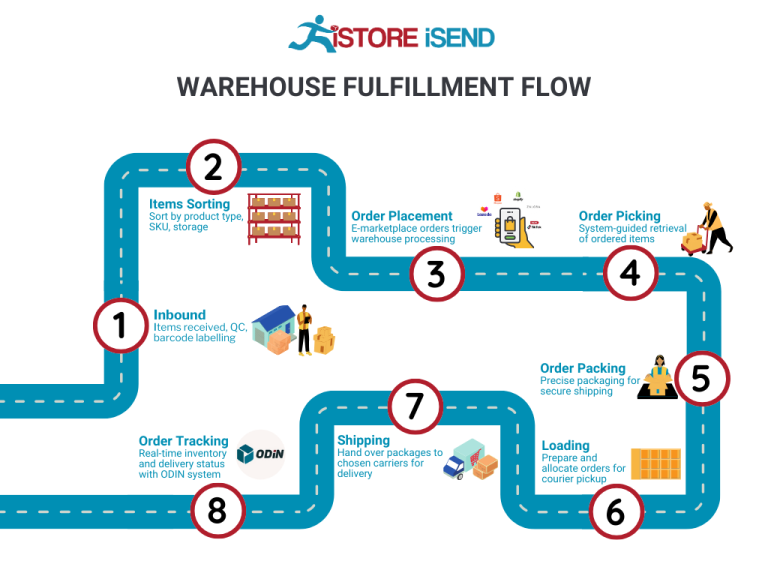
-
Payment: Sellers receive payment for their sales, minus Amazon’s fees, which cover storage, fulfillment, and shipping costs.
Pros of Using FBA
Prime Eligibility
One of the most significant advantages of FBA is that products become eligible for Amazon Prime, which is a huge selling point. Prime members are more likely to purchase items that qualify for free two-day shipping, giving FBA sellers a competitive edge.
Customer Trust
By utilizing FBA, sellers can benefit from Amazon’s established reputation. Customers often trust Amazon’s fulfillment capabilities more than individual sellers, leading to higher conversion rates. The association with Amazon also enhances the perceived reliability of the seller.
Multi-Channel Fulfillment
FBA isn’t limited to just Amazon sales. Sellers can also use FBA to fulfill orders from other platforms, such as their own websites or eBay. This feature allows sellers to streamline their logistics across multiple sales channels while enjoying Amazon’s efficient order processing.
Cons of Using FBA
High Fees
While FBA provides numerous benefits, it’s essential to be aware of the associated costs. Amazon charges various fees, including fulfillment fees (based on the size and weight of the product) and monthly storage fees (based on the volume of inventory stored). For some sellers, these fees can add up quickly, impacting overall profitability.
Strict Inventory Rules
Amazon has stringent inventory management rules, including guidelines for product condition, packaging, and labeling. Failure to comply with these rules can result in additional fees or even the removal of products from the fulfillment center. This can be particularly challenging for new sellers who may not be familiar with these requirements.

Commingling Risks
FBA products can be commingled, meaning that your inventory may be stored with products from other sellers. While this can lead to faster shipping times, it also poses risks. If a customer returns a defective product, it could potentially be mixed with your inventory, leading to customer dissatisfaction and potential damage to your seller rating.
Who is FBA Best For?
Fulfillment by Amazon is an excellent option for a variety of e-commerce businesses, but it is especially well-suited for:
-
Small to Medium-Sized Sellers: Businesses looking to scale without investing heavily in their logistics can benefit significantly from FBA. The ability to access Amazon’s infrastructure allows these sellers to compete effectively with larger companies.
-
Sellers with High Volume: If your products have high turnover rates, FBA can help streamline the fulfillment process and reduce the burden of managing logistics.
-
Sellers Targeting Amazon Prime Customers: If your target market includes Prime members, using FBA can make your products more appealing, increasing sales potential.
-
Multi-Channel Sellers: Businesses that sell across multiple platforms can simplify their operations by using FBA for all order fulfillment, regardless of where the sale originated.
In conclusion, Fulfillment by Amazon offers an attractive solution for sellers aiming to scale their operations and improve customer satisfaction. While it comes with its own set of challenges, understanding the pros and cons allows businesses to make informed decisions about whether FBA aligns with their growth strategy. For many, the benefits of leveraging Amazon’s logistics and customer service capabilities far outweigh the drawbacks.
Core Services Offered by Fulfillment Centers
Inventory Management & Warehousing
Inventory management and warehousing form the backbone of any fulfillment operation. Fulfillment centers like Amazon BWI4 provide businesses with the infrastructure to store their products securely and efficiently. This service includes receiving inventory from suppliers, maintaining optimal stock levels, and ensuring products are stored under appropriate conditions.
Benefits:
-
Space Optimization: Utilizing a fulfillment center allows e-commerce businesses to free up valuable space in their own facilities. This is particularly advantageous for small to medium-sized enterprises that may not have the capacity to manage large volumes of inventory.
-
Real-Time Inventory Tracking: Advanced inventory management systems employed by fulfillment centers provide real-time tracking of stock levels. This feature helps businesses avoid stockouts or overstock situations, ensuring that they can meet customer demand without tying up unnecessary capital in excess inventory.
-
Scalability: As businesses grow, their inventory needs will fluctuate. Fulfillment centers can easily scale their storage capacity up or down based on demand, allowing businesses to adapt without the hassle of moving locations or investing in additional warehousing.
Pick and Pack Services
Pick and pack services are essential for preparing orders for shipment. This process involves selecting items from the warehouse inventory (picking) and packaging them appropriately for delivery (packing). Fulfillment centers streamline this process through optimized workflows and technology, ensuring efficiency and accuracy.
Benefits:
-
Speed and Efficiency: Fulfillment centers employ advanced picking methods, such as batch picking or zone picking, which significantly reduce the time taken to fulfill orders. This speed is crucial for meeting customer expectations, especially in an era where fast shipping is the norm.
-
Accuracy: Automated systems and trained staff minimize errors in order fulfillment. By ensuring that the correct items are picked and packed, businesses can enhance customer satisfaction and reduce costly returns caused by shipping mistakes.
-
Cost-Effectiveness: Outsourcing pick and pack services can be more cost-effective than managing these processes in-house. Businesses save on labor costs, equipment, and training, allowing them to focus on other critical areas such as marketing and product development.
Kitting and Assembly
Kitting and assembly involve grouping individual items together to create a single product or package. This service is particularly beneficial for businesses that offer bundled products or require assembly before shipping. Fulfillment centers can handle the entire kitting process, from assembling products to labeling them for shipment.
Benefits:
-
Customization: Kitting allows businesses to offer customized products or bundles that can enhance their appeal to customers. By leveraging fulfillment centers for this service, companies can easily create promotional kits or seasonal bundles without the need for additional labor or space.
-
Streamlined Operations: By outsourcing kitting and assembly, businesses can streamline their operations. This means less time spent on logistics and more focus on core business activities such as sales and customer engagement.
-
Inventory Efficiency: Kitting helps in managing inventory more effectively by reducing the number of individual stock-keeping units (SKUs). This simplification can lead to lower storage costs and more manageable inventory levels.
Returns Management (Reverse Logistics)
Returns management, or reverse logistics, is a critical service provided by fulfillment centers. This process involves handling product returns efficiently, from receiving returned items to processing refunds or exchanges. Effective returns management is essential for maintaining customer satisfaction and loyalty.
Benefits:
-
Customer Satisfaction: A seamless returns process enhances customer experience. Fulfillment centers can quickly assess returned items and facilitate refunds or exchanges, which is vital in retaining customers in a competitive e-commerce landscape.
-
Data Insights: Returns management systems provide valuable data on customer behavior and product performance. Analyzing this data can help businesses identify trends, improve product offerings, and reduce future returns.
-
Cost Recovery: Fulfillment centers can help businesses recover value from returned items through refurbishment, repackaging, or resale. This not only minimizes losses associated with returns but can also turn a potentially negative experience into a revenue-generating opportunity.
By leveraging the core services offered by fulfillment centers, e-commerce businesses can enhance their operational efficiency, improve customer satisfaction, and ultimately scale their operations more effectively. These services allow entrepreneurs to focus on growth strategies while leaving the complexities of logistics and fulfillment to experienced partners.
How to Choose a Fulfillment Partner: A 6-Point Checklist
Location & Warehouse Network
Importance:
The geographical location of your fulfillment partner’s warehouses is crucial for minimizing shipping times and costs. A strategically placed warehouse network can ensure faster delivery to your customers, especially if they are located in high-demand areas.
Questions to Ask:
– Where are your warehouses located, and how do these locations align with my target markets?
– What is your average shipping time to major metropolitan areas?
– Do you have a network of warehouses that allows for regional distribution?
Technology & Integrations
Importance:
In today’s e-commerce landscape, having robust technology is essential for seamless operations. Your fulfillment partner should offer advanced tracking, inventory management, and reporting tools that integrate well with your existing e-commerce platform.
Questions to Ask:
– What technology do you use for order processing and inventory management?
– Can your system integrate with my current e-commerce platform (e.g., Shopify, WooCommerce)?
– Do you provide real-time tracking for both inventory and shipments?
Specializations (e.g., Cold Storage, Oversized Items)
Importance:
Depending on the nature of your products, you may require specialized fulfillment services. If you sell perishable goods, oversized items, or hazardous materials, it’s crucial to partner with a fulfillment center that has the necessary capabilities.
Questions to Ask:
– What specializations do you offer (e.g., temperature-controlled storage, handling oversized items)?
– Are you compliant with any specific regulations related to my product category?
– Can you accommodate unique packaging or shipping requirements for my products?
Scalability & Capacity
Importance:
As your business grows, your fulfillment needs will change. Choosing a partner that can scale with your business ensures that you won’t face delays or limitations as you expand your product line or customer base.
Questions to Ask:
– How do you handle seasonal fluctuations in demand?
– What is your capacity for handling increased order volume?
– Can you accommodate my growth projections over the next few years?
Pricing and Contracts
Importance:
Understanding the pricing structure and contract terms of your fulfillment partner is vital for budgeting and financial planning. Look for transparency in pricing to avoid hidden fees that can impact your bottom line.
Questions to Ask:
– What is included in your pricing model? Are there additional fees for services like returns or special packaging?
– Can you provide a detailed breakdown of costs associated with order fulfillment?
– What are the terms of your contract, and is there flexibility for renegotiation based on performance?
Customer Support & Reviews
Importance:
Exceptional customer support is essential for resolving issues quickly and maintaining a smooth operation. Researching reviews and testimonials can provide insights into a partner’s reliability and quality of service.
Questions to Ask:
– What kind of customer support do you offer (e.g., dedicated account manager, 24/7 support)?
– Can you provide references or case studies from clients in my industry?
– How do you handle issues related to order inaccuracies or shipping delays?
Conclusion
Choosing the right fulfillment partner is a critical decision that can significantly affect your e-commerce operations. By using this checklist, you can ensure that you are asking the right questions and considering the most important factors in your selection process. A well-chosen partner can not only streamline your logistics but also enhance customer satisfaction, ultimately contributing to your business’s growth and success.
Understanding Fulfillment Pricing: A Breakdown of Common Fees
Initial Setup Fees
When partnering with a fulfillment center like Amazon’s BWI4, businesses often encounter initial setup fees. These fees are typically charged to onboard a new seller account and integrate their inventory into the fulfillment system. The setup process may include creating product listings, configuring shipping preferences, and establishing inventory management protocols.
The calculation of initial setup fees can vary based on the complexity of the integration. For example, sellers utilizing more advanced features or requiring significant customization may incur higher fees. It’s essential to clarify all associated costs upfront, as some fulfillment centers might bundle these fees with additional services, making it challenging to identify the total initial investment.
Receiving Fees
Receiving fees apply when your inventory arrives at the fulfillment center. These fees cover the costs associated with unloading, inspecting, and storing products upon arrival. Typically, the fee is charged per unit received, and the amount can depend on the type of product being handled.
For example, standard items might have a lower receiving fee compared to oversized or specialized products that require additional handling. It’s important to note that any discrepancies in the shipment, such as damaged goods or incorrect quantities, can lead to additional charges. To avoid unexpected costs, ensure accurate inventory counts and packaging before sending products to the fulfillment center.
Storage Fees (per pallet/bin)
Storage fees are incurred for the space your products occupy within the fulfillment center. These fees are generally calculated on a per-pallet or per-bin basis and can vary depending on the size and type of your products. Fulfillment centers typically charge monthly storage fees, which can be influenced by factors such as peak seasons or special storage requirements.
For instance, during peak shopping periods (like the holiday season), storage fees may increase due to higher demand for warehouse space. Additionally, some fulfillment centers may offer tiered pricing, where the cost per pallet decreases as the number of pallets stored increases. To manage storage costs effectively, consider optimizing your inventory turnover rate and keeping a close eye on seasonal demand fluctuations.
Pick & Pack Fees (per item/order)
Pick and pack fees are charged for the labor involved in retrieving items from storage and preparing them for shipment. This fee is usually calculated per item or per order, depending on the fulfillment center’s pricing model. The complexity of the order can also affect this fee; for example, an order containing multiple items may incur higher fees than a single-item order due to the additional labor involved.
Some fulfillment centers may offer a flat rate for pick and pack services, while others might charge based on the number of items picked. Understanding the specifics of how these fees are calculated can help you project fulfillment costs more accurately and adjust your pricing strategy accordingly.
Shipping Fees
Shipping fees represent one of the most significant costs associated with fulfillment. These fees are determined by various factors, including the shipping method, package weight, dimensions, and destination. Fulfillment centers often negotiate bulk shipping rates with carriers, which can benefit sellers by reducing overall shipping costs.
Shipping fees can also vary depending on whether you’re using standard shipping, expedited shipping, or specialized services (like international shipping). Many fulfillment centers provide a shipping calculator to help estimate costs based on these variables. To ensure you are getting the best rates, compare quotes from different carriers and consider the impact of your shipping strategy on customer satisfaction.
Tips for Getting an Accurate Quote
-
Provide Detailed Inventory Information: When requesting a quote, provide comprehensive details about your products, including dimensions, weights, and any special handling requirements.
-
Clarify Fee Structures: Ensure you understand each fee component and how it is calculated. Ask for a breakdown of costs associated with setup, receiving, storage, pick and pack, and shipping.
-
Inquire About Seasonal Pricing: Be aware of any changes in fees during peak seasons. Understanding how these fluctuations can impact your costs will help you budget effectively.
-
Request Volume Discounts: If you anticipate high order volumes, inquire about potential discounts or tiered pricing structures that could lower your overall costs.
-
Utilize Cost Estimation Tools: Many fulfillment centers offer online calculators to help estimate total fulfillment costs based on your specific needs. Take advantage of these tools to gain insights into your potential expenses.
By understanding and managing these common fulfillment fees, e-commerce business owners can make informed decisions that contribute to their operational efficiency and profitability.
Frequently Asked Questions (FAQs) about Fulfillment
1. What is the Amazon Fulfillment Center BWI4?
Amazon Fulfillment Center BWI4, located in Clear Brook, VA, is a large-scale warehouse that specializes in storing, packing, and shipping a diverse range of products. It operates as part of Amazon’s extensive fulfillment network, ensuring efficient order processing and timely delivery to customers.
2. How does the fulfillment process work at BWI4?
The fulfillment process at BWI4 involves receiving inventory from sellers, storing products in the facility, picking and packing orders as they are placed, and then shipping them directly to customers. The center efficiently manages logistics to ensure orders are fulfilled accurately and quickly.
3. What is the difference between a warehouse and a fulfillment center?
While both warehouses and fulfillment centers store products, the primary difference lies in their functions. A warehouse is primarily for storage, whereas a fulfillment center is focused on processing orders and shipping them directly to customers. Fulfillment centers often include advanced logistics and technology to handle order management and shipping efficiently.
4. What services does Amazon Fulfillment Center BWI4 provide to businesses?
BWI4 offers a range of services, including inventory storage, order picking and packing, shipping, and returns management. It also provides access to Amazon’s customer service and Prime shipping options, allowing businesses to enhance their delivery capabilities and customer satisfaction.
5. How much do fulfillment services cost at BWI4?
Costs for fulfillment services at BWI4 vary based on factors such as the size and weight of the products, storage duration, and the volume of orders processed. Typically, businesses are charged for storage space, order fulfillment, and shipping fees. It is advisable to consult Amazon’s pricing guidelines or contact their support for specific estimates.
6. What is a 3PL, and how does it relate to fulfillment centers like BWI4?
A Third-Party Logistics (3PL) provider is a company that manages logistics and fulfillment services for other businesses. Fulfillment centers like BWI4 can be considered 3PLs as they handle storage, order processing, and shipping on behalf of sellers, allowing businesses to focus on other aspects of their operations.
7. How can businesses benefit from using BWI4 for fulfillment?
Businesses can benefit from using BWI4 by leveraging Amazon’s extensive logistics network, which enables faster shipping times, access to Amazon Prime customers, and improved operational efficiency. Utilizing BWI4 allows businesses to scale their operations without the overhead of managing their own fulfillment infrastructure.
8. What types of products can be stored and fulfilled at BWI4?
BWI4 can handle a wide variety of products, including consumer electronics, household goods, apparel, and more. However, certain restrictions apply, particularly for hazardous materials or items that require special handling. It is important for businesses to review Amazon’s guidelines for restricted products.
9. How does BWI4 ensure timely delivery of orders?
BWI4 ensures timely delivery by strategically placing fulfillment centers in high-population areas with access to major transportation hubs. This allows for efficient order processing and shipping. Additionally, the integration of advanced technology and logistics systems helps streamline operations and optimize delivery routes.
10. Can businesses track their inventory and orders at BWI4?
Yes, businesses can track their inventory and orders using Amazon’s seller dashboard. This platform provides real-time updates on inventory levels, order statuses, and shipment tracking, enabling sellers to manage their operations effectively and keep customers informed about their orders.
Conclusion: Is Outsourcing Fulfillment the Right Move for Your Business?
Evaluating the Move to Outsource Fulfillment
Outsourcing fulfillment can be a game-changer for e-commerce businesses looking to scale. By leveraging a fulfillment service, such as those offered by Amazon Fulfillment Center BWI4, companies can significantly reduce the time and resources spent on logistics. This shift allows business owners and operations managers to focus on core activities like product development, marketing, and customer engagement, rather than the complexities of storage, packing, and shipping.
One of the most compelling advantages of outsourcing fulfillment is scalability. As your sales grow, a reliable fulfillment partner can seamlessly adjust to increased demand without the need for heavy investments in infrastructure or personnel. This flexibility means you can rapidly respond to market trends and customer needs, all while maintaining the quality and speed of service that today’s consumers expect.
Additionally, partnering with an expert fulfillment provider brings invaluable logistics knowledge and advanced technology that might be otherwise inaccessible to smaller businesses. These providers often have established networks that ensure efficient shipping routes and faster delivery times, enhancing customer satisfaction and loyalty.
However, the choice of a fulfillment partner is critical. It’s essential to select a provider that aligns with your business goals and can support your growth trajectory. Consider factors such as location, technology capabilities, and customer service reputation when making your decision.
As a practical next step, conduct a thorough audit of your current shipping processes. Assess your fulfillment efficiency, costs, and customer satisfaction levels. This evaluation will help determine whether partnering with a fulfillment service is the right strategic move for your business. Taking this step could be the catalyst for your next phase of growth and success.
Important Disclaimer
⚠️ Important Disclaimer
The information in this guide is for educational purposes. Fulfillment services, pricing, and platform features change frequently. Always conduct your own due diligence and consult with providers directly before making business decisions.
